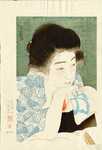| | |
| Artist: | Torii Kotondo (1900-1976) — 鳥居言人 |
| Title: | Morning Hair - Asa Negami — 朝寝髪 |
| Series: | |
| Date of first edition?: | 1931/11 |
| Date of this artwork?: | 1931 November (may not be accurate) |
| Publisher (first edition)?: | Ikeda — 池田 |
| Publisher (this edition)?: | Ikeda — 池田 |
| Medium (first edition): | Woodblock |
| Medium (this edition): | Woodblock |
| Format (first edition): | Large Oban
|
| Format (this edition): | Large Oban |
| DB artwork code: | 37151 |
| Notes (first edition)?: |
Artist Torii Kotondo (1900-1976)
Title: Morning Hair
Date Of Work: 1931 November (confirmed)
Publisher: Ikeda
Dimensions: 19 x 11.75 inches
Limited edition of only 100 prints, after which the blocks were destroyed.
Scene number 1 among 12 Ikeda published scenes.
Notes: Very rare. Kotondo's most famous design. The police banned this scene under the "Peace Preservation Law" of 1928, and confiscated the prints and blocks after 70 impressions had been printed. Why? Because of that comb in the lower right corner (too sexually suggestive. Go figure!). Ikeda marked all unsold prints with an X, gouged the blocks, and then handed them into the police (the above data is from the publisher Ikeda Tomizo's brother). So this means the actual number of prints that were sold is extremely low - maybe 30 or less, as we would expect given the rarity of this scene. To date the highest edition number I have confirmed is no. 28, so I think my estimate of 30 prints in circulation is likely.
Re-issued in the series "Twelve Aspects of Women" circa August 23, 1988. |
|
| Notes (this edition)?: |
| The following information was taken from the original web listing of this artwork. Note that there may be some inaccuracies:
Wednesday, 27 December 2006
Torii Kotondo, 1900-1976
Morning Hair
(Asanegami)
Signed Kotondo ga with red rectangular artist's seal, Shi. Published by Ikeda, the blocks carved by Maeda Kentaro and printed by Maejima. Red oval collector's seal Tobin on lower left margin. With publisher's limited edition paper seal hand-numbered on verso, Ikeda, Asanegami, dai san go (published by Ikeda, Morning Hair, number 3 from a limited edition), with red circular seal (probably Torii). Undated, published by Ikeda in 1930.
Dai oban tate-e 30 by 46.5 cm
Provenance:
James D. Tobin, Portland, Oregon
The term asanegami, literally translated as 'hair of a late riser,' is evocative of the morning following a romantic encounter, and is found in literature as far back as the 8th century, in the anthology Manyoshu (see translation by Donald Keene reprinted in The New Wave, p. 202). Apparently this was far too lascivious for Japanese authorities in 1930: after only seventy prints had been sold, the government is reported to have confiscated and destroyed the woodblocks and the remaining unsold prints. Although this story has yet to be confirmed, there is no doubt that this is an exceedingly rare print, which is indeed surprising given that it is also breathtakingly beautifully and would have likely, given the opportunity, enjoyed a very successful run of multiple editions. There is little other explanation for the rarity of this design.
Price: Sold
|
|
| Artist Bio: |
| Torii Kotondo (or Torii Kiyotada VIII) is renowned for his paintings and shin hanga prints of beautiful women. His woodblock prints, superbly carved and printed, are comparable with those of Hashiguchi Goyo and Ito Shinsui. Kotondo was born with the name Saito Akira in the Nihonbashi district of Tokyo. He was the only son among the five children of Torii Kiyotada, the seventh Torii master. The Torii school had a long tradition of painting and printmaking for the Japanese theater, extending back to the seventeenth century. Kabuki theater was still very popular in the early twentieth century and prints and painted posters were the primary means of publicity. Although Kotondo was mainly interested in studying history and archaeology, it was assumed that he would follow in his father's footsteps and join the Torii school. At age 14, Kotondo agreed to leave school and begin studies with Kobori Tomone, a yamato-e painter. Along with painting classes, Tomone taught Kotondo about the court and military practices of ancient Japan, satisfying his interest in history. A year later, he was officially adopted as the next heir of the Torii school and assumed the artist's name 'Kotondo'. While still studying with Tomone, he began designing illustrations for a theatrical magazine, Engei Gaho ('Entertainment Illustrated Magazine'), and painted kabuki posters and billboards. Torii Kotondo was the 8th Torii and the 5th Torii Kiyotada. His father was the 4th Kiyotada.
|
|
















